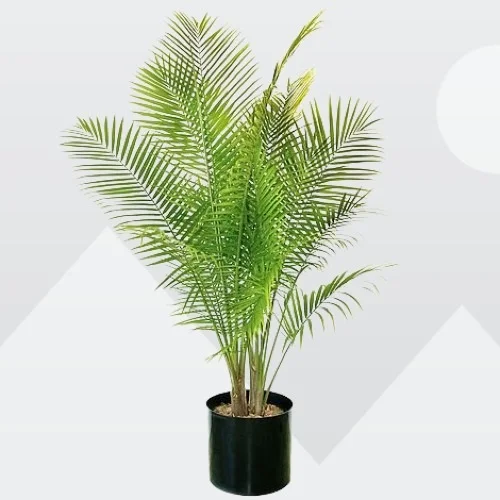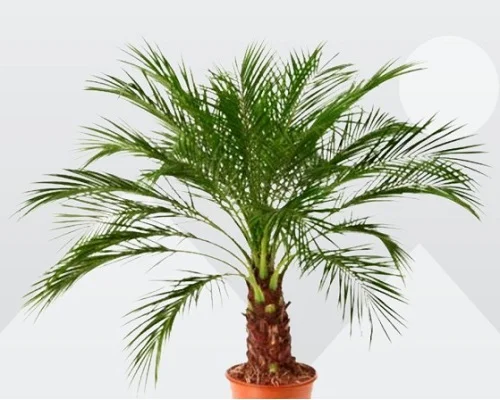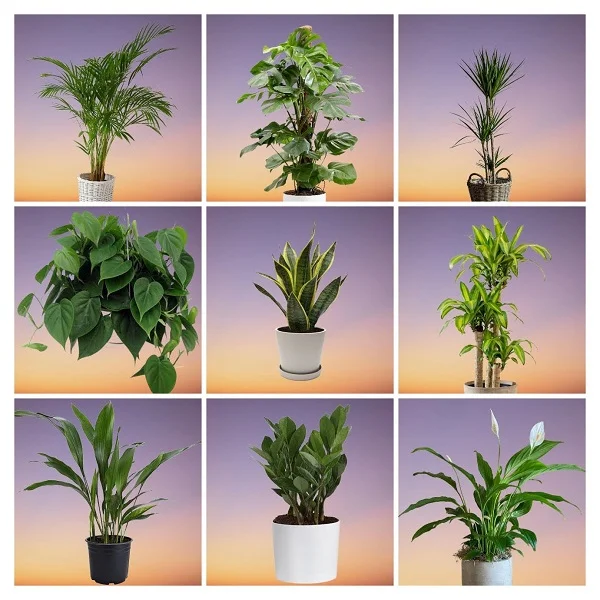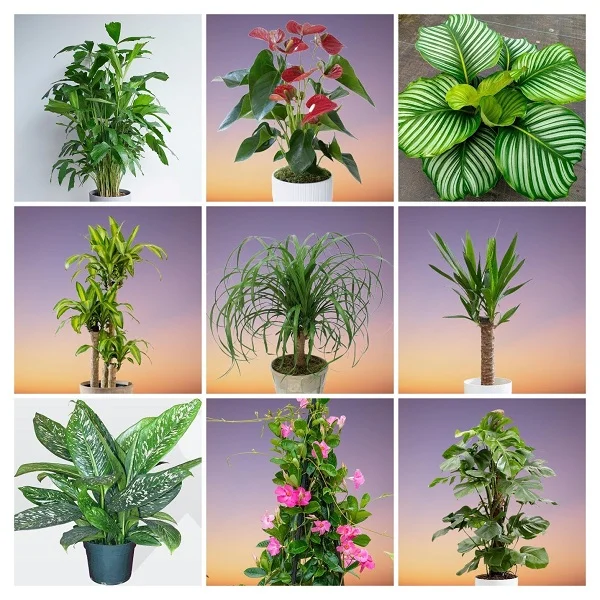Canary Island Date Palm (Phoenix canariensis) Care Indoors, Propagation and Common Problems
Some links in this post may be affiliate links
Canary Island Date Palm (Phoenix canariensis) grows best in bright indirect light, warm and humid conditions and moderately moist, well drained soil that is rich in organic matter coupled with monthly feeding in the growing season.
Phoenix canariensis also called Pineapple Palm is one of the popular palms and bears pinnate leaves with numerous leaflets on a stiff and straight rachis.
On account of its tolerance to wide range of soil and light conditions and ability to adapt to drought conditions, Pineapple Palm is among the best plants with low water needs.

Botanical name: Phoenix canariensis
Family: Arecaceae
Common names: Canary Island Date Palm, Canary Island Date Palm Tree, Pineapple Palm
Origin
Phoenix canariensis is native to the Canary Islands off the coast of Northwestern Africa where it can grow to a height of 66 feet, ocassionally growing to 130 feet. It is the natural symbol of the Canary Islands.
Size
Canary Island Date Palm is a slow-grower and exclusively propagated by seed. It grows to a height of only 6 feet when grown indoors. The leaves are 2-4 feet long and the leaflets are about 6-10 inches long, narrow, straight and stiff. On account of its size and tolerance to low light conditions, Pineapple Palm is one of the low-light, tree-like plants for dark spaces in the home, office and other places.
Fruit
Canary Island Date Palm fruit is an oval, yellow to orange, edible 2 cm drupe with a large seed. It resembles a small, thin-fleshed date.
Toxicity
The foliage in Canary Island Date Palm Tree is non-toxic to both humans and pets as indicated by ASPCA.
However, it bears sharp spines at the base of the frond which are extremely sharp and toxic. They often snap off once they penetrate the skin and may cause pain and swelling in the affected part of the body. Always wear leather gloves, eye protection and thick clothing when handling this palm.
Related Plants
Canary Island Date Palm is closely related to Phoenix roebelenii (Pygmy Date Palm) and Phoenix dactylifera, the true date palm.
Where to Buy
Are you looking to acquire these Pineapple Palms for your plant collection? They are available online on Etsy (Link to Etsy).
Canary Island Date Palm Care Indoors
Canary Island Date Palm prefers bright indirect light (filtered light), average warmth of 15-260C, moderate humidity of 55-65% and moderately moist, well drained, all purpose soil that is rich in organic matter coupled with monthly feeding during the growing season.
Phoenix canariensis care requires repotting every 2-3 years only when it becomes pot-bound. Regular pruning is necessary to keep it neat and tidy as well as minimize pest and disease infestations. Keep reading for more on these conditions and how to provide them..

Light Requirements
Canary Island Date Palm grows best in bright indirect light. Keep it away from direct sunlight to avoid scorching the fronds. It can tolerate some light shade but it will grow much slower.
Where the natural lighting is not enough, you may use grow lights to supplement it. Take a look at these full spectrum grow lights on Amazon.
Turn the pot regularly to ensure that the palm receives light on all sides for uniform growth as well as prevent lopsided growth.
Watering
Water your Canary Island Date Palm thoroughly until water runs through the drainage hole and allow the top 2-3 inches of soil to dry out between waterings.
Lessen watering in the cold season as growth is minimal to maintain the soil slightly moist but do not allow the soil to dry out completely.
Use chlorine-free water for watering. Like all palms, Pineapple Palm is sensitive to chlorine and other chemicals dissolved in water. Ensure that the water is at room temperature to avoid shocking this tropical plant.
Avoid getting the base of the palm wet to prevent rotting. Do not allow the palm to sit in soggy soil as it may lead to root-rot and eventual death of the palm.
Temperature and Humidity
Canary Island Date Palm requires an average warmth of 15-260C to thrive. If the temperature is comfortable for you it is ideal for this palm. Keep it away from cold drafts to avoid sudden changes in temperatures as they may result in stunted growth and brown leaf tips.
Canary Island Date Palm Tree has no need for extra high humidity. Moderate to high humidity of 55-65% is ideal for this palm. However, too low humidity may lead to brown leaf tips. Therefore, where the air is too dry, set the pot on a wet pebble tray or use a cool mist humidifier to raise humidity.
Occasionally clean the mature leaves by spraying with a strong jet of running water to get rid of dust as well as discourage pest infestations. Make sure that there is good air circulation to minimize fungal diseases.
Fertilizer
Feed Canary Island Date Palm monthly with a balanced, liquid fertilizer during the growing period to encourage a lush growth. Stop feeding in the cold season as growth is minimal at this time.
To prevent fertilizer build up which is indicated by leaf burn and brown spots, regularly flush the soil. Run a stream of water through the soil until water comes out through the drainage hole. Allow the stream of water to run for some time and repeat the process several times.
Potting Soil
The best soil for Phoenix canariensis should be rich in organic matter and free-draining to prevent it from getting soggy while providing the required nutrients. Most all purpose potting mixes are ideal for the palm.
Repotting
Repot Canary Island Date Palm every 2-3 years at the beginning of the growing season when the palm has become pot-bound. Use a pot 1-2 sizes larger than the current one. Ensure that the pot has a drainage hole to prevent the soil from getting soggy to avoid root-rot. Check out these ceramic pots with drainage holes and saucer on Amazon.
Pruning
Pruning Canary Island Date Palm is easy. Cut away the old brown and dry fronds near the soil surface to maintain the palm tidy. Cut off only old brown and dry fronds. Any frond with green continues to provide food (nutrients) to the palm.
Where the seeds are required for propagation, allow the fruits to mature and drop then cut away the spent flower stalk. If the seeds are not required, cut away the flower stalk immediately to prevent it from wasting energy on developing the flowers and seeds.
Propagation
Phoenix canariensis propagation is done exclusively from seeds. Seed germination can take up to 4-6 months and requires keeping the soil moist through out the period.
Canary Island Date Palm propagation from seeds
Seed germination is difficult and may take up to 3-4 months. It also requires that the soil be kept moist through out the period.
Fill the rooting container with loose, well-drained potting mix and slightly moisten the soil.
Sow the seeds in the moist soil and cover the seeds slightly with soil. Do not bury them too deep to hasten germination.
Cover the set up with polythene cover to create a greenhouse effect and place in a well-lit, warm place at about 300C. Warmth and humidity are important for germination.
Keep the soil moist through out the period until germination of the seeds takes place. Germination may take upto 3-4 weeks.
Lower the temperature slightly after germination and maintain the soil moist until the new Pineapple Palms are well established after which you can begin routine care.

Phoenix canariensis Problems
Canary Island Date Palm problems include brown leaf tips, yellow leaves, brown leaves, pests and diseases among others. Keep reading for more details on these problems, their remedies and solutions.
Brown leaves
The lower leaves in Canary Island Date Palm may turn brown and droop due to age; remove by cutting and not pulling. If the browning of the leaves is general and accompanied by rotting, the reason is root-rot due to soggy soil. Learn how to treat root-rot in houseplants.
Pests
Canary Island Date Palm is rarely attacked by pests. However, spider mites, scales and mealy bugs may attack the weak plants. Regularly check underneath the leaves for these pests. Isolate the affected plant to prevent spread to the other plants and treat it appropriately for the pests. Learn how to identify and treat pests in houseplants.
Brown leaf tips
There are four reasons for brown leaf tips in Canary Island Date Palm. Trim off the brown tips with sterilized scissors. One reason for brown leaf tips is dry air (low humidity). To elevate humidity, set the pot on a wet pebble tray or use a cool mist humidifier. Learn more on how to raise humidity for houseplants.
The second reason for brown leaf tips in Phoenix canariensis is underwatering. Water the palm liberally while allowing the top 2-3 inches of soil to dry out between waterings to keep the soil moderately moist at all times during the growing season.
Decrease watering in the cold season to keep the soil slightly moist but do not allow the soil to dry out completely. Ensure that the pot has a drainage hole and that the soil drains easily. Read more on how to water houseplants the correct way.
The third reason for brown leaf tips in Pineapple Palm is cold drafts. Keep the palm away from drafts from windy doors and drafty windows to maintain an average warmth of 15-260C. Check out this guide on understanding temperature for houseplants.
The fourth reason for brown leaf tips in Canary Island Date Palm is is damage by touching. Place the palm away from the line of traffic to avoid bruising.
Yellow leaves
Yellow leaves in Canary Island Date Palm are caused by underwatering. Water the palm thoroughly during the growing season and allow the top 2-3 inches of soil to dry out between waterings. Cut down on watering in the cold season as growth is reduced at this time but do not let the soil dry out completely.
Brown leaf spots
There are two possible causes of brown leaf spots in Canary Island Date Palm. Remove the affected leaves and discard. One cause is overwatering. Keep the soil moderately moist at all times during the growing season but not soggy. Ascertain that the pot has a drainage hole and the soil is free-draining to avoid getting soggy soil.
The second cause of brown leaf spots in Phoenix canariensis is sudden decrease in temperature due to cold drafts. Keep the palm away from cold drafts from drafty windows and doors to maintain an average warmth of 15-260C.
You liked it? Share on social media.
Related Content
Amazon Associates Disclosure
Homeplantsguide.com is a participant in the Amazon Services LLC Associates Program, an affiliate advertising program designed to provide a means for sites to earn advertising fees by advertising and linking to amazon.com.





